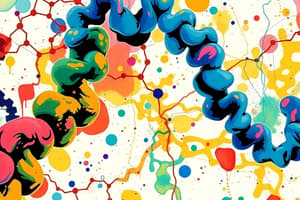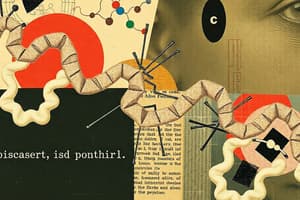Podcast
Questions and Answers
What percentage of protein does the adult body contain?
What percentage of protein does the adult body contain?
- 10-15%
- 20-25%
- 12-18% (correct)
- 5-10%
Which of the following represents the correct definition of protein?
Which of the following represents the correct definition of protein?
- Simple sugars used for energy
- Macromolecules containing carbon, hydrogen, and nitrogen (correct)
- Minerals required for body functions
- Small molecules made up of nucleotides
Which type of amino acid is characterized by having a negatively charged side chain?
Which type of amino acid is characterized by having a negatively charged side chain?
- Neutral polar amino acid
- Neutral non-polar amino acid
- Acidic amino acid (correct)
- Basic amino acid
What is the name of the bond that joins amino acids together?
What is the name of the bond that joins amino acids together?
How are amino acids classified based on their interaction with water?
How are amino acids classified based on their interaction with water?
Which chain length represents a tripeptide?
Which chain length represents a tripeptide?
What is the primary structure of a protein?
What is the primary structure of a protein?
What is the role of the liver in relation to amino acids?
What is the role of the liver in relation to amino acids?
Flashcards
Protein
Protein
Large macromolecules made of amino acids, containing carbon, hydrogen, oxygen, nitrogen, and sometimes sulfur.
Functions of Protein
Functions of Protein
Proteins are essential for building body structures, enzymes, hormones, and immune functions.
Amino Acids
Amino Acids
The building blocks of proteins, with 20 common types; 10 are essential and must be acquired from diet.
Peptide Bond
Peptide Bond
Signup and view all the flashcards
Levels of Protein Structure
Levels of Protein Structure
Signup and view all the flashcards
Dipeptide and Tripeptide
Dipeptide and Tripeptide
Signup and view all the flashcards
Classification of Amino Acids
Classification of Amino Acids
Signup and view all the flashcards
Primary Structure of Protein
Primary Structure of Protein
Signup and view all the flashcards
Study Notes
Protein Structure
- Proteins are large macromolecules composed of carbon, hydrogen, oxygen, and nitrogen.
- Some proteins also contain sulfur.
- Adult bodies are approximately 12-18% protein.
- Proteins have four levels of structural organization.
Protein Functions
- Proteins perform a variety of functions, including structural support, regulation (e.g., hormones), contraction (e.g., muscles), immunological defense (e.g., antibodies), transportation (e.g., hemoglobin), and catalysis (e.g., enzymes).
- Proteins form the framework of tissues like bone, skin, and hair.
- Proteins like enzymes speed up chemical reactions in biological systems.
- Hormones like insulin regulate blood-sugar levels.
- Hemoglobin carries oxygen in the blood.
Amino Acids
- The building blocks of proteins are amino acids.
- There are 20 common amino acids.
- The liver synthesizes 10 of these amino acids; the other 10 are essential and must be obtained from the diet.
- Amino acids are composed of an amino group (NH2), a carboxyl group (COOH), a hydrogen atom (H), and a variable side chain (R group).
Amino Acid Classification
- Amino acids are classified according to their interaction with water:
- Neutral non-polar amino acids are hydrophobic and interact poorly with water.
- Neutral polar amino acids are hydrophilic and interact favorably with water.
- Acidic amino acids are negatively charged.
- Basic amino acids are positively charged.
Protein Structure Levels
- Primary Structure: A linear sequence of amino acids linked by peptide bonds.
- Secondary Structure: Regular substructures formed within a polypeptide chain; examples are alpha helices and beta sheets, stabilized by hydrogen bonds.
- Tertiary Structure: Three-dimensional structure of a single polypeptide chain, resulting from folding of the secondary structure; folding is determined by interactions between amino acid side chains.
- Quaternary Structure: Arrangement of multiple polypeptide chains (subunits) to form a functional protein. Hemoglobin (a protein responsible for oxygen transport in red blood cells) is an example.
Protein Metabolism
- Metabolism encompasses all chemical processes in the body.
- Catabolism breaks down complex molecules into simpler components.
- Anabolism builds complex molecules from simpler ones.
- Digestion catabolizes proteins into amino acids, which are then used to build new proteins for bodily function.
Chain of Amino Acids
- The basic building blocks of proteins are amino acids.
- A chain of 2 amino acids is called a dipeptide.
- A chain of 3 amino acids is called a tripeptide.
- A chain of 4-9 amino acids is called a peptide.
- A chain of 10 or more amino acids is called a polypeptide.
Summary
- Proteins are essential macromolecules with diverse roles in life processes.
- Amino acids are the fundamental building blocks of proteins.
- The hierarchical structure of proteins (primary, secondary, tertiary, quaternary) impacts their form and function.
- Protein structure and function are tightly intertwined.
Studying That Suits You
Use AI to generate personalized quizzes and flashcards to suit your learning preferences.



